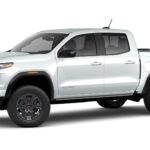The Subaru lineup is renowned for its adventurous spirit, safety, and reliability, and two of its most popular models, the Forester and the Outback, often find themselves head-to-head in buyer considerations. Both offer Subaru’s signature Symmetrical All-Wheel Drive, ample cargo space, and a reputation for longevity, but they cater to slightly different needs and preferences. Choosing between the Subaru Forester and Outback requires a detailed look at their distinct characteristics to determine which best aligns with your lifestyle.
Size and Dimensions: Compact SUV vs. Wagon-SUV Crossover
The most immediately noticeable difference between the Forester and Outback is their body style and size. The Subaru Forester firmly plants itself in the compact SUV category. It boasts a boxier design, maximizing interior space within a manageable footprint. This makes the Forester exceptionally easy to maneuver in city environments and park in tight spots, while still offering generous headroom and legroom for passengers.
On the other hand, the Subaru Outback blurs the lines between a station wagon and an SUV, often categorized as a wagon-SUV crossover. It’s longer and lower than the Forester, presenting a more car-like silhouette with increased ground clearance compared to a traditional wagon. This extended length translates to more rear cargo space and a different driving feel, leaning slightly towards a more traditional car-like experience with added ruggedness.
Performance and Engine Options: Efficiency vs. Power
Under the hood, both the Forester and Outback offer distinct engine choices that influence their performance and fuel economy. The Subaru Forester typically features a naturally aspirated 2.5-liter four-cylinder engine. This engine prioritizes fuel efficiency and provides adequate power for daily driving and light off-road adventures. It’s a reliable and economical choice for those focused on practicality and cost-effectiveness.
The Subaru Outback, while also offering a similar 2.5-liter four-cylinder as its base engine, distinguishes itself by providing an available turbocharged 2.4-liter four-cylinder engine. This turbocharged option significantly boosts horsepower and torque, delivering more robust acceleration and enhanced towing capacity. For drivers who prioritize stronger performance, especially when carrying passengers or cargo, or frequently encounter hilly terrain, the Outback’s turbo engine is a compelling upgrade.
Interior and Comfort: Practicality vs. Refinement
Inside the cabin, both the Forester and Outback reflect Subaru’s commitment to functionality and comfort, but with subtle variations. The Forester’s interior design emphasizes practicality and visibility. Its upright seating position and large windows offer excellent outward views, contributing to a sense of spaciousness and ease of driving. The materials are durable and geared towards active lifestyles, prioritizing resilience and ease of cleaning.
The Outback’s interior, while equally practical, leans slightly towards a more refined and car-like experience. The cabin often features higher-grade materials in upper trims, and the lower profile can create a more intimate, car-like feel. While both offer comfortable seating for five, the Outback’s wider stance might provide a touch more shoulder room in the rear.
Cargo Space and Practicality: Versatility in Different Forms
Cargo capacity is a crucial factor for many SUV and wagon buyers, and both the Forester and Outback excel in this area, albeit in slightly different ways. The Subaru Forester, with its boxy shape, maximizes vertical cargo space. Its taller roofline allows for easier loading of bulky items and offers more headroom for taller cargo.
The Subaru Outback, due to its longer body, provides a greater overall cargo volume, particularly when the rear seats are folded. Its lower roofline might make loading very tall items slightly less convenient than in the Forester, but the extended length is advantageous for carrying longer items and provides more usable space with the rear seats up, especially in the cargo area length.
Safety Features: Subaru’s Commitment to Protection
Subaru has consistently earned top safety ratings across its model lineup, and both the Forester and Outback are no exception. Both vehicles come standard with Subaru’s EyeSight Driver Assist Technology, a suite of safety features including adaptive cruise control, automatic emergency braking, lane departure warning, and lane-keeping assist.
While both models offer similar core safety technologies, specific features and their availability might vary slightly depending on the trim level and model year. It’s always recommended to consult the latest specifications for each model year to compare the exact safety offerings. However, both the Forester and Outback prioritize safety and provide drivers with peace of mind.
Price and Value: Balancing Features and Budget
Pricing is a significant consideration, and generally, the Subaru Forester tends to be more budget-friendly than the Outback. The Forester, as a compact SUV, typically starts at a lower MSRP, making it an attractive option for buyers seeking value and Subaru’s core features at a more accessible price point.
The Subaru Outback, positioned as a larger, more versatile wagon-SUV crossover with available upgraded engine options and often more premium features in higher trims, usually commands a higher starting price. The Outback justifies its price with its added size, potential for more powerful engine, and sometimes, a more upscale interior ambiance.
Choosing Between Forester and Outback: Which Subaru Suits You Best?
The decision between the Subaru Forester and Outback ultimately hinges on your individual needs and priorities.
Choose the Subaru Forester if:
- You prioritize maneuverability and ease of parking, especially in urban environments.
- You value maximum headroom and vertical cargo space.
- Fuel efficiency is a primary concern.
- You prefer a more traditional, boxy SUV shape.
- Budget is a key consideration.
Choose the Subaru Outback if:
- You desire a more car-like driving experience with wagon versatility.
- You need more overall cargo volume and length for longer items.
- You want the option of a more powerful turbocharged engine.
- You appreciate a slightly more refined interior and a longer vehicle stance.
- You occasionally need to tackle more challenging terrains or tow heavier loads (with the turbo engine).
Both the Subaru Forester and Outback are excellent choices, offering Subaru’s renowned all-wheel-drive capability, safety, and reliability. By carefully evaluating your needs and comparing the distinct strengths of each model, you can confidently select the Subaru that perfectly complements your adventures.

